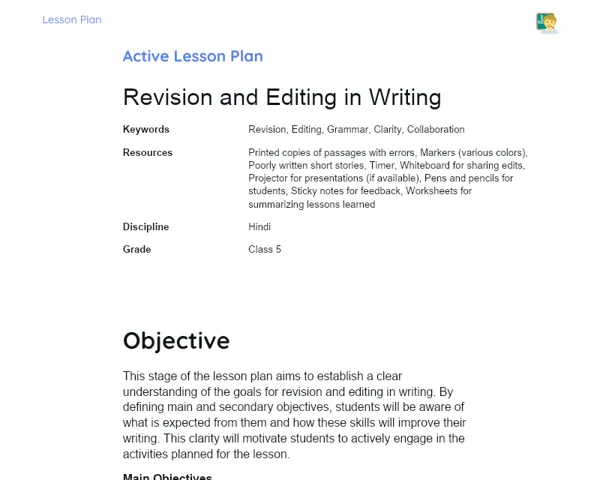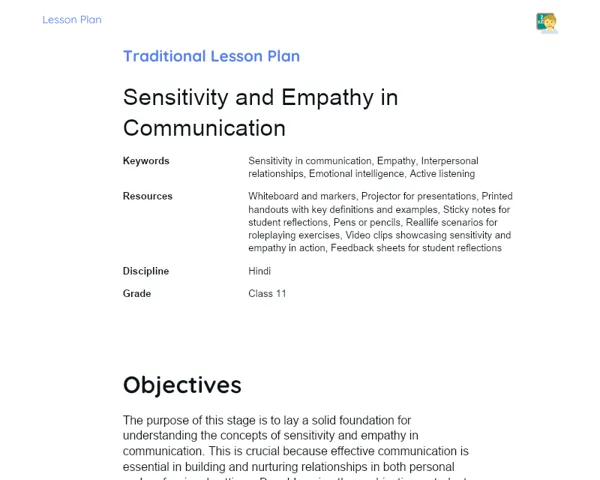Lesson Plan | Socioemotional Learning | Finding Books in the Library
| Keywords | Library, Book Finding, Emotional Intelligence, Self-Awareness, Self-Management, Social Skills, Library Sections, Treasure Hunt Activity, RULER Method, Teamwork, Goal Setting, Cultural Stories |
| Resources | List of clues for Library Treasure Hunt, Selection of children's books from various sections (fiction, non-fiction, reference), Writing materials (notebooks, pencils) for goal-setting activity, Comfortable seating arrangement for mindful breathing, Charts or posters explaining the library layout and Dewey Decimal System, Emotion regulation tools (like stress balls or calming visuals), Whiteboard or flip chart for sharing session, Timer for managing activity durations |
| Codes | - |
| Grade | Class 3 |
| Discipline | Hindi |
Objectives
Duration: (10 - 15 minutes)
The purpose of this step is to set the foundation for the lesson by clearly defining what students are expected to learn regarding both the process of finding books in the library and the emotional aspects involved in that process. This helps students to focus on both the cognitive skills of locating books effectively and the socioemotional skills they will need to navigate the library environment confidently. By articulating objectives, students can also become more aware of their feelings and reactions during the learning process, which is critical for their emotional development.
Main Objectives
1. Students will learn how to identify different sections of the library and the types of books available in each section.
2. Students will develop their emotional intelligence by recognizing how they feel when searching for a book and understanding how to manage these feelings.
Introduction
Duration: (15 - 20 minutes)
Emotional Warmup Activity
Breathe and Find Your Focus
Mindful Breathing
1. Gather the students in a comfortable seated position, ensuring they are all facing forward.
2. Ask the students to close their eyes gently or lower their gaze to the floor to minimize distractions.
3. Guide students to take a deep breath in through their nose, feel their lungs expand, and hold it for a count of three.
4. Instruct students to slowly exhale through their mouths, imagining releasing any worries or distractions.
5. Repeat this process for a total of five breaths, reminding students to focus on the sensation of the air entering and exiting their bodies.
6. After the final breath, invite students to open their eyes and notice how they feel in the moment, encouraging them to remain present and focused.
Content Contextualization
Finding a book in the library is not just about choosing a nice cover; it's about diving into a world full of possibilities and adventures! Imagine walking into the library and seeing shelves upon shelves of stories waiting to be discovered. Just like how in life we search for friends or activities that excite us, books too can evoke feelings and thoughts. Sometimes, we might feel overwhelmed by all the choices, while other times we might feel excited about starting a new adventure. Understanding our emotions during this process can help us not only pick the right book but also enjoy our time in the library. Today, we are going to explore both the sections of our library and our feelings while we search for our next favorite read.
Development
Duration: (60 - 75 minutes)
Theory Guide
Duration: (20 - 25 minutes)
1. The library is divided into various sections, each representing different categories of books such as fiction, non-fiction, reference, and children's literature. Understanding the layout helps students know where to look for different genres.
2. Fiction books are stories that are created from the imagination, including novels and tales like 'Gulliver's Travels' or 'Harry Potter.' They can evoke various emotions and teach students about different experiences.
3. Non-fiction books provide factual information about the real world, including science, history, and biography. For example, books like 'A Brief History of Time' explain complex ideas in an understandable way.
4. Reference books, such as dictionaries and encyclopedias, are valuable for research and homework, helping students find facts quickly. Knowing how to locate these can aid in effective studying.
5. Children's literature encompasses stories specifically written for young readers, like folktales and fairy tales, which can enhance imagination and moral lessons.
6. The Dewey Decimal System is a way of categorizing books based on their subject matter. Understanding this system helps students navigate the library more efficiently.
7. The importance of respecting library rules and being considerate to others while sharing the space can enhance the library experience for everyone.
Activity with Socioemotional Feedback
Duration: (15 - 20 minutes)
Library Treasure Hunt
In this engaging activity, students will embark on a 'Library Treasure Hunt,' where they will be divided into small groups. Each group will receive a list of clues leading them to different sections of the library, alongside specific books or genres they need to find. They will collaborate, communicate their findings, and express how they feel about the books they discover. This activity encourages teamwork and allows students to practice their social skills while also reflecting on their emotional responses during the treasure hunt.
1. Divide students into small groups of 4-5.
2. Provide each group with a list of clues or questions related to different sections of the library.
3. Encourage students to search for the books together, discussing each other's thoughts and feelings about the books they find.
4. After 30 minutes of hunting, gather the groups for a sharing session where they can express their emotions and experiences during the activity.
5. Facilitate a discussion on how it felt to work as a team and the importance of supporting one another.
Discussion and Group Feedback
After the groups have completed the treasure hunt, guide a conversation using the RULER method. Start by helping students recognize the emotions they felt during the activity. Ask them to share moments when they felt excited, frustrated, or happy while searching for books. Encourage them to understand why they felt those emotions and how it relates to finding something new and enjoyable.
Next, label those emotions by having students name what they felt. They can discuss how they expressed those feelings during the hunt—did they jump with joy, whisper in excitement, or help each other calm down when they felt overwhelmed? Finally, guide them to regulate their emotions by reflecting on how they can approach similar situations in the future, emphasizing the importance of patience and support among peers. This discussion should help foster a deeper emotional awareness and enhance their interpersonal skills.
Conclusion
Duration: (15 - 20 minutes)
Reflection and Emotional Regulation
After the treasure hunt, gather students in a circle and ask them to share their thoughts about the challenges they faced during the activity. Encourage them to discuss moments when they felt excited or frustrated while searching for their books. Have each student reflect on how they managed their emotions in those situations. Encourage them to think about specific strategies they used to stay calm or to feel excited, such as taking deep breaths or supporting their friends. This conversation will help students articulate their experiences and acknowledge their emotional responses, fostering a deeper understanding of how they can approach similar situations in the future.
Objective: The objective of this subsection is to encourage students to self-assess and manage their emotions effectively. By reflecting on their experiences from the treasure hunt, students can identify strategies that helped them navigate challenges, enhancing their emotional intelligence and self-awareness as they learn to regulate their feelings in various situations.
Glimpse into the Future
To wrap up the lesson, guide students in setting personal and academic goals based on their experiences in the library. Ask each student to think about one book they want to read next and one skill they want to improve regarding their library usage. Encourage them to share these goals with the class for inspiration and support. For example, a student might say they want to read a specific series or improve their ability to search for books independently. This will help them relate the learning experience to their individual aspirations.
Setting Goals:
1. Read at least one new book from a different section of the library by the end of the month.
2. Improve my ability to find books independently by creating a list of tips from this lesson.
3. Support classmates in their treasure hunts by sharing what I have learned about the library. Objective: The objective of this subsection is to strengthen students' autonomy and encourage practical application of their learning. By setting personal and academic goals, students take ownership of their learning journey, fostering a sense of responsibility that can lead to continued academic and personal growth.



